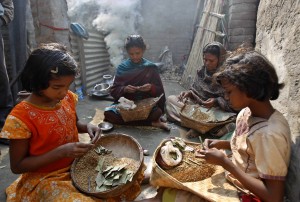
In this Thursday, Jan. 26, 2012, photo, 11-year-old Sagira Ansari, right, rolls bidi tobacco with her family at their house in Dhuliyan, in the eastern Indian state of West Bengal. Sagira is among hundreds of thousands of children toiling in the hidden corners of rural India. Sagira and her family earn 75 rupees ($1.50) for every 1,000 bidis rolled which brings in about 7,500 rupees ($150) a month. India’s poverty levels have declined by over 7 percentage points in five years, according to government data. AP PHOTO/RAFIQ MAQBOOL
NEW DELHI—India’s poverty levels have declined by more than seven percentage points in five years, according to government data released on Monday, but the country’s northeast has become more impoverished.
The figures from the influential Planning Commission used new household consumer expenditure methods to calculate that poverty levels fell from 37.2 percent in 2004-05 to 29.8 percent in 2009-10.
The decline was sharpest in rural areas, where the poverty ratio fell from about 42 percent in 2004-05 to just under 34 percent in 2009-10.
Although several states saw their poverty ratios plummet by more than ten percentage points, a number of states in India’s remote northeast experienced a rise in poverty levels.
“In Assam, Meghalaya, Manipur, Mizoram and Nagaland, poverty in 2009-10 has increased,” the commission said in a statement.
India’s poverty estimates are used to determine public access to welfare benefits. Anyone living below the so-called poverty line is entitled to subsidized food and cooking fuel distributed through state-owned stores.
The Planning Commission ran into trouble last year when it suggested that any villager earning around 50 cents a day could not be classified as poor.
It later backed away from the definition after activists accused the government of trying to water down poverty estimates and reduce the official number of poor in the country of 1.2 billion people.
The criteria for measuring poverty levels vary from state to state in India but are now generally based on household spending on food, education and other areas.